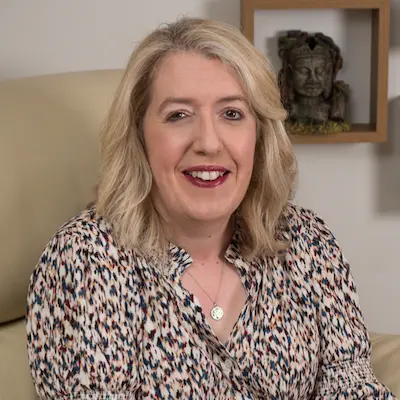The article below is a version of the video interview I gave above.
Tell us a bit more about what walk and talk therapy is?
Jump to section titled: Tell us a bit more about what walk and talk therapy is?Walk and talk therapy, also known as eco-therapy, involves conducting therapy sessions while walking in nature. It’s a form of therapy that combines the benefits of exercise and being in nature with the benefits of traditional psychotherapy.
Can you tell us more about the benefits of walk and talk eco-therapy?
Jump to section titled: Can you tell us more about the benefits of walk and talk eco-therapy?There are many benefits to this form of therapy. First, walking and being in green spaces in nature has been shown to have a positive impact on mental health and helps to regulate physiological systems in our bodies. Being outdoors can help reduce stress, anxiety, and depression, and improve overall mood.
For many clients, having therapy outdoors can feel a lot less intimidating simply because they are often walking side-by-side with their therapist instead of sitting face-to-face under the gaze of their therapist in a room.
This is particularly helpful for clients who find it difficult to form close relationships or talk about their feelings or emotions due to experiencing dissociation.
Feeling ‘dissociated’ means feeling disconnected from your feelings, emotions, memories, sensations in your body, and the world around you. Most commonly, people dissociate as a reaction to experiencing distressing or traumatic events both in childhood and in later life that they were unable to control or stop happening.
Hayley Marshall, a TA psychotherapist who has been working outdoors with clients for the past 16 years, describes the therapeutic outdoor space as a “living third” with “the therapeutic practitioner allowing oneself to be shaped by the ecological third.” Marshall wrote “it is important not to go looking for or trying to set the stage (outdoors).
Rather, one needs to tune in with an ecological receiver that has access to the particulars of the client’s unconscious and the happenings of the place, eventually speaking to the (therapy) process from there.”
Interestingly, Marshall created the word “eco-dissociation” and wrote “in eco-dissociation the person actively seeks an animate (living) place of refuge, that is, an actual place to mediate experiences of a traumatic or troubling human environment.”
Do you think this kind of therapy is suitable for everyone?
Jump to section titled: Do you think this kind of therapy is suitable for everyone?Walk and talk eco-therapy can be suitable for most clients. Obviously, It’s important to take into account a client’s physical abilities and any potential limitations before recommending walk and talk eco-therapy.
How does walk and talk eco-therapy differ from traditional psychotherapy?
Jump to section titled: How does walk and talk eco-therapy differ from traditional psychotherapy?Well, traditional psychotherapy typically takes place in a therapy room, which can feel intimidating and pressured for some clients. Walk and talk eco-therapy, on the other hand, takes place outdoors in nature, which can help clients feel more relaxed and open.
Additionally, being outdoors offers many welcomed sensory ‘distractions’ such as the sounds of birdsong and the flapping of wings, the sudden appearances of other animals such as ducks marching in a line by a stream, the wind in the trees, changes in weather, and also other people walking by the therapist and client. All of these non-verbal distractions can be used metaphorically and imaginatively to make meanings for the client’s experiences in the past and the present, also becoming part of the therapy process.
Marshall encourages eco-therapists to ask their clients, “What is alive here?” in what she described as “the intense magic of the outdoor encounter.” Being outside in nature increases both the therapist and client’s ability for reflective thinking and reverie or being lost in pleasant thoughts and daydreams inducing a sense of calm.
What kind of issues can be addressed through walk and talk eco-therapy?
Jump to section titled: What kind of issues can be addressed through walk and talk eco-therapy?Walk and talk eco-therapy can be helpful for a variety of issues, including anxiety, depression, stress, and relationship issues. The ways that clients behave and interact with the outdoor space and with their therapists outdoors in nature may be reflective of the ways they interact in other relationships in their lives. For example, some clients may walk much faster than their therapist or hold back, walking slowly behind, rather than always side-by-side.
It is important for eco-therapists to be aware of the feelings and emotions they feel whilst outdoors with their clients as these can give useful therapeutic information. This is called counter-transference.
Being in nature can help clients gain perspective on their problems and find new solutions. Marshall wrote “we work from the position of humans being among all kinds of others rather than being at the centre of things, working not just in or from but through an ecological space.”
Tell me about where you conduct your walk and talk eco-therapy sessions?
Jump to section titled: Tell me about where you conduct your walk and talk eco-therapy sessions?I conduct my walk and talk eco-therapy sessions near Formby beach and nature reserve, which is just a few minutes away from my therapy rooms. It’s a beautiful and peaceful location that’s perfect for this type of therapy.
How can individuals book a session with you?
Jump to section titled: How can individuals book a session with you?Individuals can contact me directly to schedule a session. I offer a free 10-minute telephone consultation for clients who are interested in learning more about walk and talk eco-therapy and how it can help them.
